
Peru-ing the Day I Promised This
Editors Note: JoeHoya should need no introduction to the ES community. This DC Foodies blogger/prolific commenter/all-around genius recently traveled to Peru, and is nice enough to share a novel blog post about his culinary experiences.
For the record, Machu Picchu was lost for almost 400 years. So when you think about it, the fact that it’s taken me more than a month to write about our trip to Peru is really pretty insignificant by comparison.
In mid-August (two days after the earthquake, to be exact), my wife and I flew to Peru to volunteer in Cusco for a week. The program was organized by GlobeAware, a terrific American non-profit that arranges volunteer opportunities in countries around the world. And despite the fact that our destination had just suffered a MASSIVE EARTHQUAKE, the hardest part of our trip was actually getting out of DC’s National Airport. Suffice it to say, we sat on the tarmac for the better part of a Thursday night before we were informed that our flight was canceled.
But we got out on Friday and arrived in Cusco with an hour to spare before our program started on Saturday morning. And since this isn’t a travelblog, that’s all I’m going to say about the trip that isn’t directly related to things we ate and drank.
Because Cusco is almost 12,000 feet above sea level, almost everyone who visits experiences some degree of altitude sickness. Thankfully, Cusquenas have a remedy for this (and just about any other minor discomfort you can think of): mate de coca.
Yes – this is a beverage brewed from coca leaves.
Yes – those are the leaves that are processed to extract the chemicals used to make cocaine.
No – mate de coca is nothing like cocaine. In fact, it’s pretty much exactly the opposite. It has sedative properties that soothe the upset stomach and headache most commonly associated with altitude sickness. And it definitely helped us adjust, though it was a few days before we were even climbing stairs without doubling over and wheezing like a smoker who just sprinted for a bus.
Our first meal was nothing too crazy – chicken tenders, in fact. But they came with a Peruvian twist: quinoa. Although not featured in White Men Can’t Jump as a food that starts with the letter Q, quinoa is the versatile, protein-rich “Mother Grain of the Andes” that has been cultivated since Incan times. Its grains resemble those of couscous and are most often prepared in much the same way. But this chicken used the quinoa as an element of its coating, and the results were truly delicious. The quinoa grains added an extra bit of crunch that everyone seemed to enjoy. (Photo above)
(Bonus fact: Quinoa is actually considered Kosher L’Pesach and can be eaten during Passover.)
And because we were in Cusco, we felt that we couldn’t leave without sampling two other meats that we had been alternately warned and pumped up about: cuy (Okay, fine…guinea pig) and alpaca.
We didn’t get to try either until our final night in Cusco, when our volunteer group went out to dinner together to celebrate the trip. One of our fellow volunteers was brave enough to order the guinea pig, and I made it a point to order the lomo de alpaca, or alpaca tenderloin.
The alpaca was a bit tough, but still moist and tasty. More than anything, it reminded me of grilled pork in terms of both appearance and texture. But the taste was gamier, more like buffalo meat. If I had to classify it, I’d call alpaca another other white meat.
Thankfully, the restaurant we ate in was smart enough to realize that very few of the people who order the guinea pig REALLY want their meal to come out looking like a guinea pig. The presentation resembled that of a quartered chicken (no fur, claws or entrails on this one!), and the taste and texture were most reminiscent of duck, though significantly greasier. Definitely glad I opted for the alpaca.
While we were in Cusco, we also made it a point to seek out some of the traditional beverages of the region – including the disturbingly popular Inka Cola. About as subtly colored as Mountain Dew, Inka Cola delivers that bubble gum sweetness most American sodas lack. But it does so without the use of corn syrup, so I guess that’s something. To call it an acquired taste is a bit of an understatement.
Oh yeah, we may have sampled a few of the local beers, as well.
All along the streets in Cusco and the surrounding towns, you’ll see stores and homes with red flags and banners outside their doors. This is to signal the availability of chicha, a truly traditional beverage. Peruvians have found a way to turn their second most prevalent crop, corn, into a fermented smoothie-like beverage that they drink in large tumblers either plain or with mashed strawberries. What’s their secret for turning corn into something far more fun? Saliva.
Okay…it’s probably better if you don’t know that until AFTER you’ve tried the stuff, which has a boozy sweetness and a scent that anyone who has ever taken a brewery tour would recognize as active fermentation. Not a bad drink, but not enough of an enticement to get me to drink strangers’ saliva. I’m old-fashioned like that.
By far, the most interesting culinary treats we experienced were not the meats, or even the beverages. The indigenous fruits we were offered easily took that title with their strange appearances, textures, and even tastes.
Our first morning there, we were introduced to something called a ‘granadilla,’ and it fascinated all of us throughout our stay. On the surface, it looked similar to an orange or a tangerine. But the skin was more like a shell that needed to be cracked and peeled away. Below the skin lay a spongy white layer that can best be compared to Wonder bread. And what do you find in the center as a reward for all your hard work? This:
That’s right, a mass of seeds in a gelatinous pouch. It pretty much looks like an exposed brain. But it’s actually tasty, with a lightly tart sweetness similar to that of passion fruit. It was a big hit, always the first fruit to run out at the breakfast table.
We also ate something called a ‘pepino’ that looked like the photo negative of a plum. The body was smooth and round, but it was uniformly yellow with thin purple stripes. Having bought it without asking anything about its taste or texture, we assumed that it would taste sweet, or tangy, or both. We were more than a little disappointed to find out that the pepino is actually a small melon, and it tastes like a cross between a honeydew and a cantaloupe with a texture like a pepper. On a recent trip to Harris Teeter, I was surprised to see that they actually carry pepino in their produce section, though I would have much preferred to see a granadilla.
The trip was amazing because of everything we saw and did while we were down there, but the food and drink were definitely an experience all by themselves.
Previously on ES: This Little Piggy Has Hair and Claws
Photos: NicoleKen at VirtualTourist (Mate de Coca), Charlene Yamaoka, JoeHoya

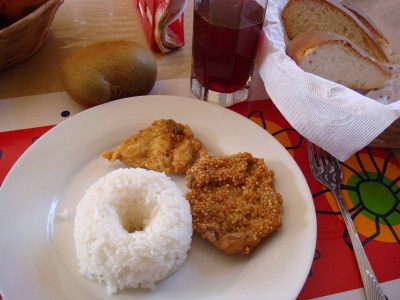
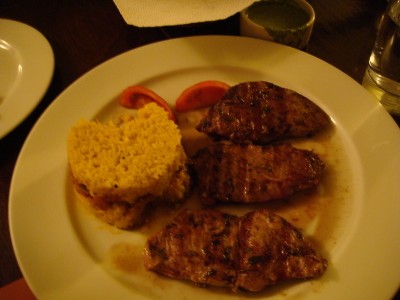
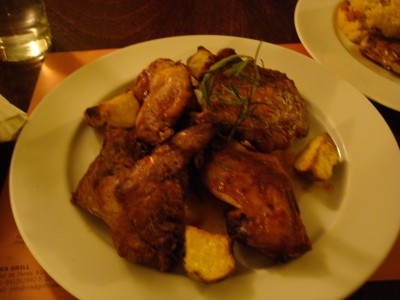
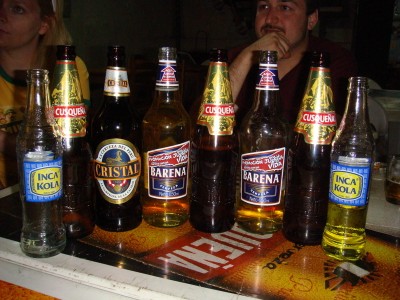

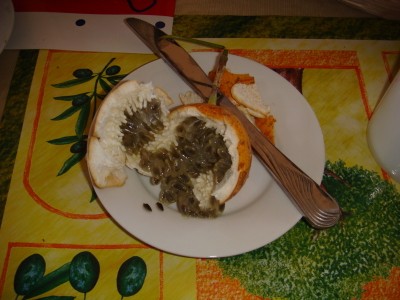

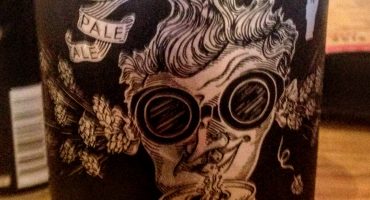


Great stuff. The granadilla looks absolutely disgusting. haha. So you only eat the center, not the white, spongy layer?
Yup…guess humans don’t quite have the market cornered on superfluous packaging, after all.
Though I’d say our styrofoam peanuts have pretty much raised it to an art form at this point.
Thanks for posting this, Gansie! Sorry for the delay (and the length of the post)!
I have to give credit to BS on this one–he’s the one that labored through and posted it. so, thanks, BS, for posting the longest blog entry ever!
but seriously, great narrative on the food there.
i’ve actually been meaning to cook, or even try, quinoa. does anyone have any quinoa recipes or tips? and too effing funny about the kosherness. will have to bring that to the next passover sedar.